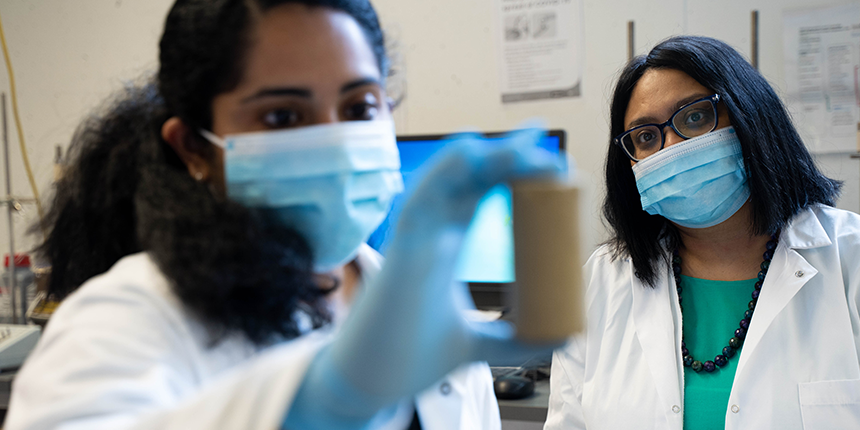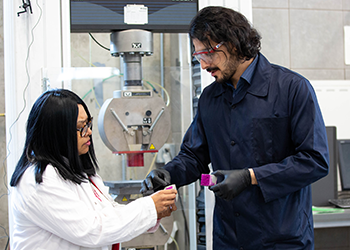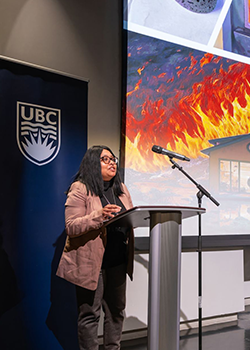
Sumi Siddiqua, a geo-environmental engineer at the University of British Columbia, is researching how to use soil and industrial byproducts to create low-carbon construction materials and methods that are sustainable and environmentally safe.

How often do you think about the soil beneath your feet? For Sumi Siddiqua, P.Eng., the natural materials that make up our soil are a constant source of discovery and inspiration. “When we build things, we use all manufactured materials like steel and concrete. But soil is a natural product. When you work with natural material, it's more exciting because it's different in every place you work."
Siddiqua is a geo-environmental engineer at the University of British Columbia. In her lab, she and her students identify materials and methods of construction that make use of industrial byproducts and natural soil as alternative construction materials that are more sustainable, can reduce the use of concrete and cement, and have less harmful impact on the environment.
A great example of Siddiqua’s work is the multi-purpose project of creating soil mixtures for rammed earth construction. Rammed earth is an ancient technique, where soil is mixed with other materials and then compressed to form aesthetic or load-bearing walls. In modern times this method has been abandoned in exchange for concrete construction, but Siddiqua sees no reason why it can’t be brought back.
“When they're using soil as is, it doesn't have high strength like concrete. Our engineers cannot use that for buildings or structural support systems. We started to use other additives, industrial byproducts, and to make a new material which is as strong as concrete."

In British Columbia, where there are plenty of pulp and paper mills, one of the byproducts currently sent to landfills is wood fly ash. This ash is a fine powder that is close to cement in characteristics and is often added to concrete to enhance its strength while reducing the carbon footprint. By using this material as an additive, Siddiqua and her team can reduce the amount of waste going to landfill, recycle the waste product from the mills, and reduce the use of cement and concrete by using rammed earth. This lowers the overall carbon emissions of future construction projects.
“At the end, we will be getting low-carbon building materials or low-carbon materials for road construction and embankment slope stabilization," Siddiqua explained.
This process is already used by construction companies such as Innovative Earth, based in Grande Prairie, Alberta, and Kelowna, British Columbia. "Innovative Earth has worked in collaboration with us, as we have used different industrial residues to increase strength, and they took our ideas of using wood ash whenever they do construction in BC.”
This ability to use local materials, both natural and additive, makes the construction more easily built on location without importing materials. BC Housing is also interested in potential applications in remote cities and towns, and Indigenous housing.
“For rammed earth, you're using local soil. That means keeping local heritage intact when you are dealing with those constructions. Our goal is to have training facilities within the community. This way, the people can participate in the construction, developing skills for the future,” Siddiqua explained, outlining the potential of these future projects.
Another fascinating aspect of working with soil as a natural product, is that other natural products can be used to impact the character of the ground. “We have industrial collaborators that are working with organic soil, which is very soft,” Siddiqua explained. There are many places, in Alberta for example, where the land is composed of organic soil, which can be difficult to build on, as the foundations can creep and deform as the soft soil shifts and moves below it.
“We are looking at how to improve the quality of that soil. I'm focusing on the use of microbes. We have introduced certain bacteria to this organic soil in different ways, such as injection methods where we inject a solution that provides nutrition for those bacteria to grow within the soil. And then we saw the strength of the soil improve over a period of time,” Siddiqua explained.
Alternative natural methods being explored also includes the use of fungi. Fungi can provide roots and structure that hold onto the soil, creating a natural strength that it previously lacked. The goal is to continue to refine and develop these processes so they can be easily used on site across Canada.
Wood fly ash makes sense as an industrial byproduct in BC, but there are other sources of industrial waste that Siddiqua would like to see reused in construction. She is currently looking at the possibility of using microbes to identify and extract heavy metals from mine tailings, so they can be treated and then reused.
“This is the direction lot of people are working in. They use microbes and they use different chemical treatments to process and extract valuable materials. We work on a metal-organic framework; using a chemical reaction we can identify how to absorb heavy metals and if you can absorb heavy metals, then you can process them as value-added products,” Siddiqua explained.

All of the projects that Siddiqua and her students work on in her lab are ones that she is personally invested in. “Our overall goal is to support the geo-environmental engineering related research targeting climate change.” Siddiqua emphasizes that the projects are important, but so too is her education for the next generation of engineers. “I'm training the next generation of engineers with a skill set focused on clean technology and climate resilient infrastructure. That means it's not only a small number of people that are directly impacted, but also it is impacting the community and society in large.”
For Siddiqua, one of the best parts about being an engineer is being able to put solutions into action. “Knowledge is not valuable if you don't know how to use it and that bridge happens through an engineer, bringing solutions to our daily life.”
Siddiqua’s solutions start with the ground beneath her feet, but it doesn’t end there. She hopes her work towards creating a cleaner, more sustainable environment for future generations will be taken up by the next generation of engineers, as she and her students continue probing the possibilities of building with soil and reducing waste in construction.
Engineers build more than just bridges. Building Tomorrows is a series that highlights the important contributions of engineers and the many ways they help to make our world a better place.


